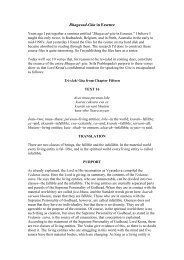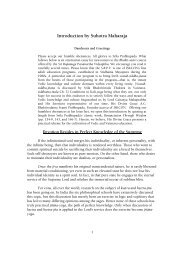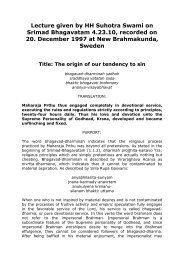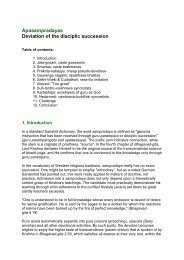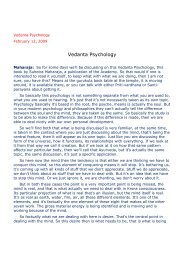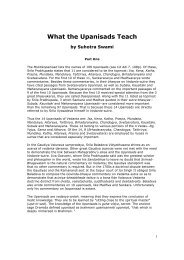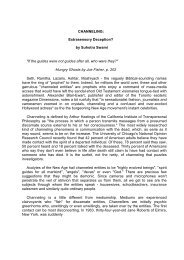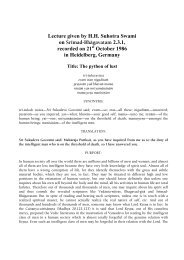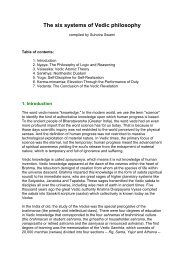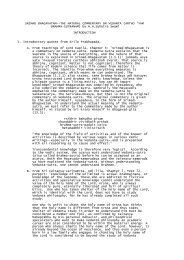Deviant Vaisnava Sects - Suhotra Maharaja Archives
Deviant Vaisnava Sects - Suhotra Maharaja Archives
Deviant Vaisnava Sects - Suhotra Maharaja Archives
You also want an ePaper? Increase the reach of your titles
YUMPU automatically turns print PDFs into web optimized ePapers that Google loves.
VAISNAVAS, devotees of Lord Krsna, use the term prakrta-sahajiya to refer to<br />
persons who imitate the signs of prema, pure love for God, while still addicted to the<br />
low-class pleasures of illicit sex and intoxication. The sahajiyas imagine that they feel the<br />
divine emotions of Krsna and His dearest devotee, Srimati Radharani. Yet they don't<br />
understand that before we can savor the pleasure shared by Radha and Krsna, we must rid<br />
ourselves of lustful desires for sensual pleasure.<br />
The word sahaja means "easy." A prakrta-sahajiya wants the bliss of spiritual life<br />
without the struggle to attain it. And the word prakrta means "materialistic." Because the<br />
sahajiyas forgo the standard disciplines of bhakti-yoga, the divine love they apparently<br />
show never gets beyond material lust.<br />
The prakrta-sahajiyas mistake lust—the disease of the soul—for spiritual<br />
advancement. So instead of curing lust, they wind up cultivating it.<br />
Bhagavad-gita (16.23-24) recommends that we follow sastra-vidhi, the directions of<br />
the scriptures, to purify ourselves of lust. Sastra-vidhi especially calls for us to give up<br />
meat-eating, illicit sex, gambling, and intoxication and to chant the Hare Krsna mahamantra.<br />
This gradually readies us for raga-marga, the path of natural attraction to Krsna,<br />
reserved for highly advanced devotees.<br />
The prakrta-sahajiyas, however, go easy on the scriptural regulations. They stay<br />
attached to materialistic enjoyment of the senses. But this sense enjoyment blinds them,<br />
and therefore their ideas of Krsna, Krsna's devotees, Krsna's service, and love of Krsna<br />
are but a faulty creation of their lower nature.<br />
According to the Bengali historian Dr. S. B. Das Gupta, the Bengali sahajiya<br />
movement can be traced back long before the time of Sri Caitanya Mahaprabhu, to the<br />
reign of the Buddhist Pala dynasty (c. A.D. 700-1100). At that time a secret cult of the<br />
name Sahajayana arose within the Vajrayana ("Diamond Vehicle") school of Buddhism.<br />
Sahajayana Buddhists abandoned ritualism and study of scriptures as useless. They<br />
practiced a "yoga of sex" in which they took consciousness to be the unity of the male<br />
and female principles, sometimes called upaya and prajna, or karuna and sunyata. The<br />
Sahajayana Buddhists wrote many songs, known as the Caryapadas, expressing their<br />
philosophy in mysterious language.<br />
Later, under the Sena kings, Vaisnavism became ascendant in Bengal when the great<br />
spiritual master Jayadeva Gosvami won royal patronage for it. The Buddhist sahajiyas<br />
then absorbed aspects of <strong>Vaisnava</strong> philosophy and twisted them. They renamed their<br />
upaya and prajna principles "Krsna" and "Radha," imagining Radha-Krsna to represent<br />
the highest state of bliss attained by men and women on the sahajiya path.<br />
In the thirteenth century, with the Islamic occupation of northern India and Bengal,<br />
the sahajiyas were influenced by the practices and philosophy of the Sufis. The word sufi<br />
comes from the Arabic word saf, meaning "sacred," and it signifies a mystical Islamic



